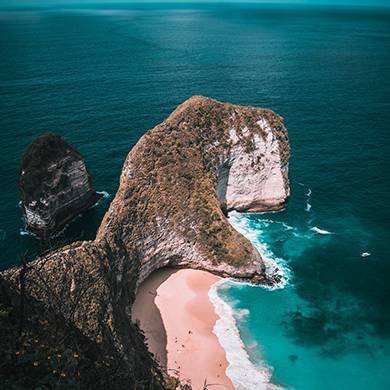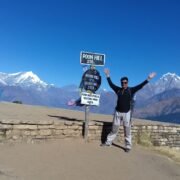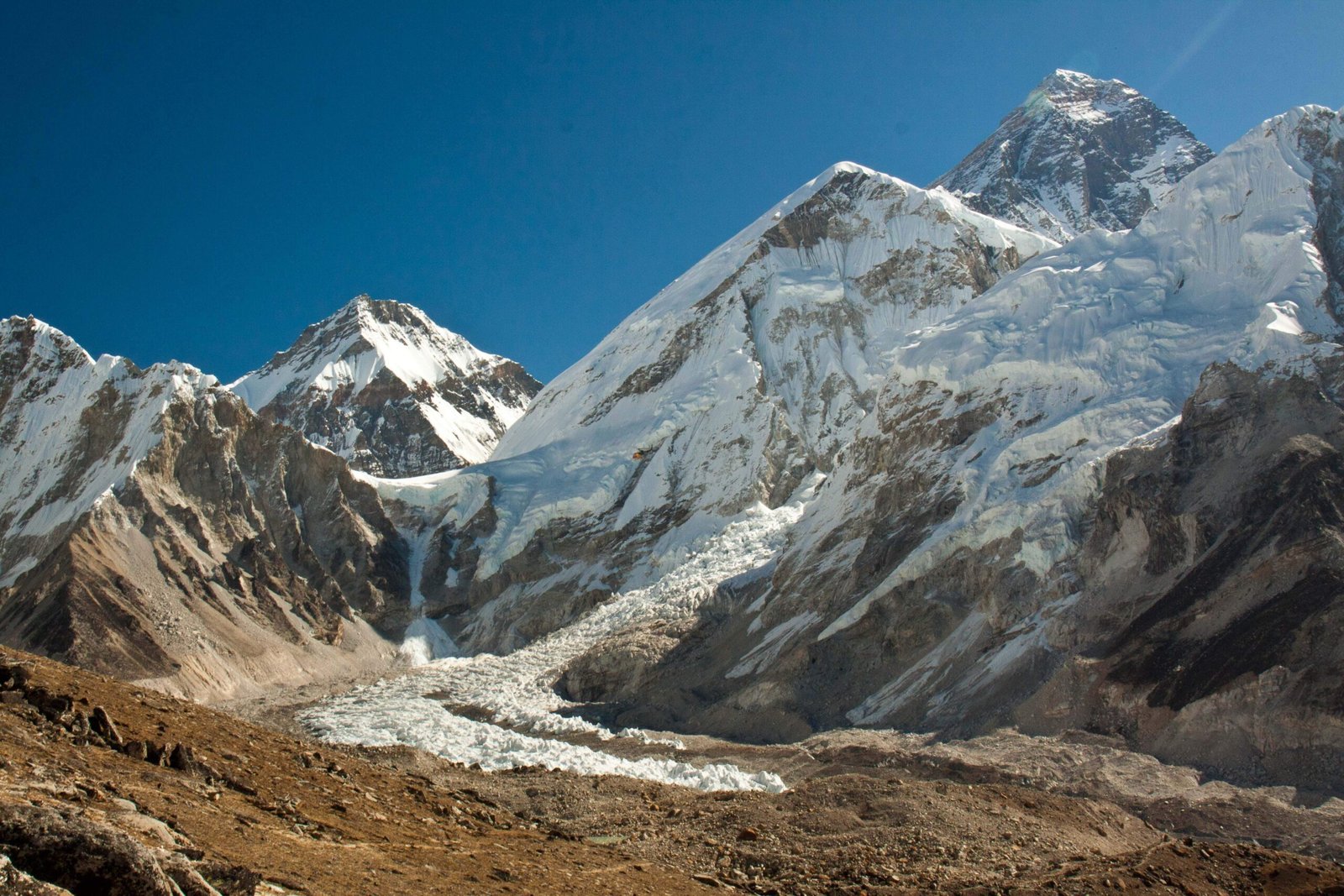
Kala Patthar – The Best Viewpoint of Mount Everest with Mountain King Treks | Experience the Roof of the World
Introduction
Rising proudly at an elevation of 5,545 meters (18,192 feet) above sea level, Kala Patthar — meaning “Black Rock” in Nepali — is widely celebrated as the best viewpoint of Mount Everest and one of the most rewarding highlights of the Everest Base Camp Trek. This remarkable peak, located above the small settlement of Gorakshep in Nepal’s Khumbu region, provides trekkers with the closest and most awe-inspiring panoramic view of the Everest massif — including Mount Everest (8,848.86 m), Lhotse (8,516 m), Nuptse (7,861 m), Pumori (7,161 m), and the elegant Ama Dablam (6,812 m).
For many adventurers, standing on the rocky summit of Kala Patthar Everest Viewpoint is the moment when the dream of seeing Everest truly comes alive. Unlike the base camp itself, where the mighty peak hides behind Nuptse’s ridgeline, Kala Patthar offers a clear, unobstructed, and soul-stirring view of Mount Everest in all its glory. During sunrise and sunset, the golden rays illuminate the Himalayas, painting the peaks in hues of orange and pink — an experience that feels almost otherworldly.
Reaching Kala Patthar is not just about altitude or adventure; it’s a spiritual encounter with the Himalayas. As you climb through thin air, each breath brings you closer to the mountain that has inspired explorers for generations. When you finally reach the summit and gaze upon Everest’s shining crown, a deep sense of achievement, humility, and peace fills your heart — the essence of Himalayan trekking.
With Mountain King Treks, the Best Trekking Agency in Nepal, your journey to Kala Patthar becomes more than just a trek — it transforms into a once-in-a-lifetime experience. Our expert Sherpa guides lead you safely through the challenging trails, ensuring proper acclimatization and comfort along the way. You’ll enjoy authentic local hospitality, breathtaking scenery, and professional support that makes your adventure safe, memorable, and deeply fulfilling.
Whether you’re a passionate photographer capturing Everest’s golden glow, a nature lover seeking solitude at the top of the world, or a traveler chasing the ultimate Himalayan dream, Kala Patthar promises an experience that will stay with you forever. Here, among the giants of the Earth, you don’t just see the mountains — you feel them.
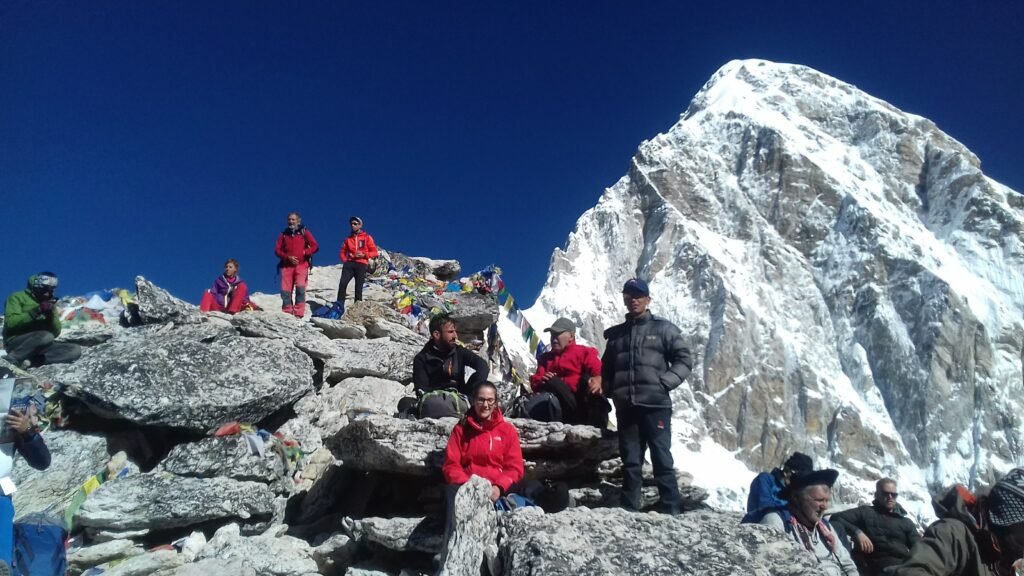
Where Is Kala Patthar Located?
The legendary Kala Patthar Everest Viewpoint is located in the heart of Nepal’s Khumbu region, within the Sagarmatha National Park, a UNESCO World Heritage Site. Perched at an impressive altitude of 5,545 meters (18,192 feet), Kala Patthar stands above the small settlement of Gorakshep (5,164 m) — the last teahouse stop on the Everest Base Camp Trek. Its commanding position on the southwestern ridge of Mount Pumori (7,161 m) makes it one of the most accessible high-altitude viewpoints in the entire Everest region.
From this incredible vantage point, trekkers are rewarded with a 360-degree Himalayan panorama unlike anywhere else on Earth. Directly to the east towers Mount Everest (8,848.86 m) — so close that you can see its iconic black pyramid peak piercing the sky. Surrounding it are the majestic giants Nuptse (7,861 m) and Lhotse (8,516 m), forming an awe-inspiring wall of ice and rock that glitters under the sunlight. To the north, the graceful Pumori rises elegantly behind you, while Ama Dablam (6,812 m) and Thamserku (6,623 m) stand proud to the south, completing this breathtaking Himalayan amphitheater.
Kala Patthar’s location gives trekkers something even Everest Base Camp cannot — a clear, unobstructed view of the summit of Mount Everest. While the base camp sits on the Khumbu Glacier and offers an up-close look at the expedition routes and icefalls, Everest’s actual peak remains hidden behind Nuptse’s ridge from there. But from Kala Patthar’s summit, trekkers are treated to the closest and most complete visual of Everest’s summit that any non-climber can experience.
The Khumbu Valley, where Kala Patthar lies, is home to the Sherpa people, famous for their mountaineering skills, deep Buddhist traditions, and warm hospitality. The trail leading up to Gorakshep passes through iconic Himalayan villages such as Namche Bazaar, Tengboche, Dingboche, and Lobuche, each offering incredible scenery and insight into mountain culture.
From Gorakshep, trekkers can continue to the Everest Base Camp Trek or explore other sections of the Everest Region Trek for an extended adventure. This makes Kala Patthar not only a destination in itself but also a strategic viewpoint that links multiple treks in the Everest region.
Because of its strategic location, Kala Patthar is often the highest point reached by trekkers on the Everest Base Camp journey. Many adventurers start their Kala Patthar ascent early in the morning, climbing in the cold, thin air to witness the most spectacular sunrise over Mount Everest — a golden moment that captures the soul of the Himalayas.
Reaching this sacred spot with Mountain King Treks, the Best Trekking Agency in Nepal, ensures that your experience is safe, enriching, and unforgettable. Our expert team leads you to the summit of Kala Patthar through well-acclimatized itineraries, combining adventure with comfort and authentic Himalayan hospitality.
Kala Patthar Everest Viewpoint is not just a point on a map — it’s a destination of dreams, standing as a natural throne overlooking the mightiest mountain on Earth. It represents the pinnacle of every trekker’s journey — a place where the sky touches your soul and Everest fills your eyes.
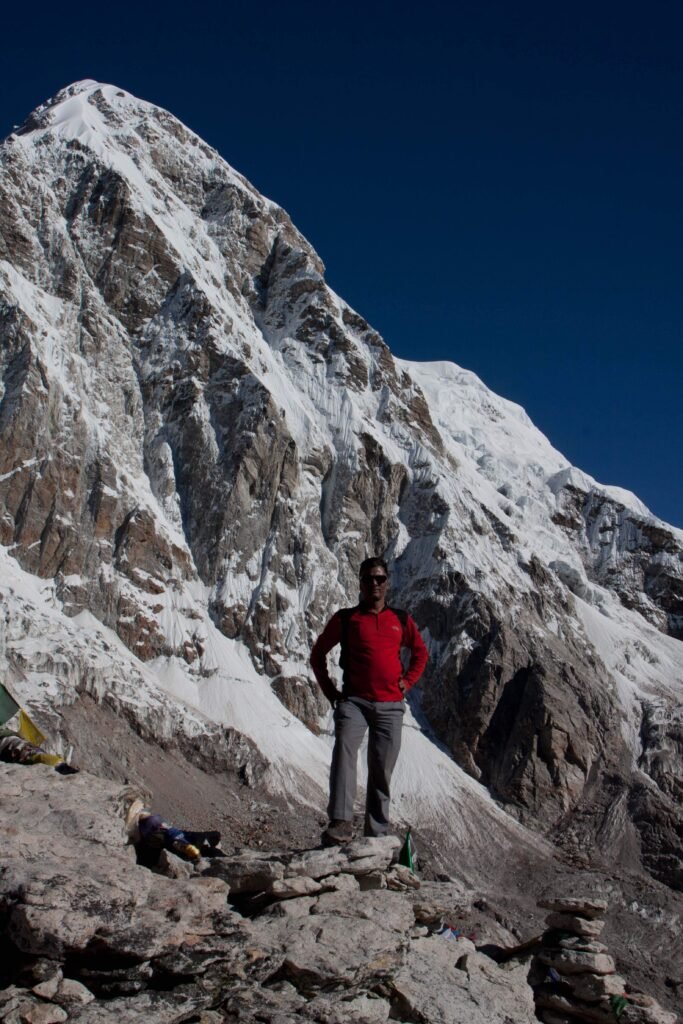
The Meaning and Significance of “Kala Patthar”
The name “Kala Patthar” comes from two Nepali words — “Kala” meaning black and “Patthar” meaning rock. Literally translated, it means “Black Rock”, a name inspired by the dark, rugged boulders that dominate its steep slopes. But beyond its simple translation, Kala Patthar Everest Viewpoint holds a far deeper meaning — both culturally and spiritually — for trekkers and the local Sherpa people of the Khumbu region.
Origin of the Name – The Black Rock of the Himalayas
The striking black cliffs of Kala Patthar stand out against the brilliant white glaciers and snowcapped peaks of the Everest range. This contrast gives it the appearance of a solid black sentinel guarding Mount Everest, making it a distinct and recognizable feature on the Everest trail. Early trekkers and local guides began calling it “Kala Patthar” to describe its unique appearance — and over time, the name became legendary across the trekking world.
However, Kala Patthar is more than just a physical landmark. For those who climb it, the name also symbolizes strength, endurance, and resilience — qualities every trekker must embrace to reach its summit. The journey is steep and demanding, but the reward at the top embodies the essence of the Himalayas: raw beauty, challenge, and triumph.
Local Sherpa Beliefs and Symbolism
For the Sherpa people, who have lived for generations in the shadow of Everest, mountains are sacred beings — the homes of deities and protectors of life. Kala Patthar is often regarded with quiet reverence as part of the spiritual landscape of Sagarmatha (Mount Everest). Sherpas believe the mountains hold divine energy, and reaching high places like Kala Patthar brings one closer to the gods.
On the trail and summit, it’s common to see prayer flags (lungta) fluttering in the wind, carrying prayers and blessings across the valleys. These colorful flags symbolize peace, strength, and compassion — virtues that reflect the Sherpa way of life. Each climber who stands atop Kala Patthar becomes part of this sacred space, surrounded by the rhythmic sound of wind and the endless white horizon of Himalayan peaks.
Why It’s Iconic for Trekkers Worldwide
For trekkers from around the world, Kala Patthar Everest Viewpoint represents the ultimate achievement without mountaineering gear. It’s the closest point to Mount Everest that can be reached on foot, offering an unmatched view of the world’s tallest mountain. From its summit, you don’t just see Everest — you feel its presence, towering silently yet powerfully in front of you.
Kala Patthar has become an emotional and spiritual landmark for adventurers. The thin air, biting cold, and endless ridgelines test your endurance — but as you stand at the top, all exhaustion fades into awe. Many trekkers describe it as a life-changing moment, where time seems to stop and the vastness of nature fills every sense.
Over the years, Kala Patthar has earned its place as one of the most photographed spots in the Himalayas, featured in countless documentaries, travel books, and expedition stories. It’s a destination that connects hearts from across the world — uniting everyone under one shared dream: to stand face to face with Mount Everest, the crown of the Earth.
When you journey to Kala Patthar with Mountain King Treks, the Best Trekking Agency in Nepal, you don’t just visit a mountain — you experience a sacred connection to nature, culture, and self-discovery. Our professional team ensures that every step of your adventure carries meaning, safety, and inspiration, just as the black rock itself has symbolized endurance and spirit for generations.
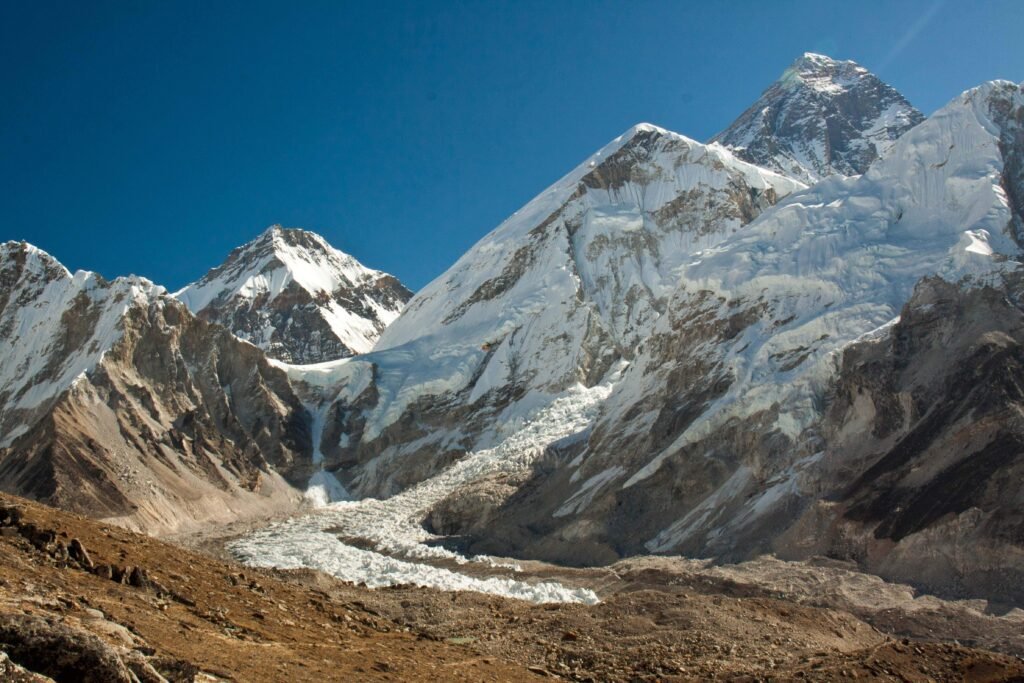
Why Kala Patthar Is the Best Viewpoint of Mount Everest
Among all the magnificent places in the Everest region, none compare to the unparalleled views from Kala Patthar. Known as the best viewpoint of Mount Everest, Kala Patthar offers trekkers what no other place on Earth can — a complete, 360° panoramic spectacle of the Himalayan giants that seem close enough to touch. Standing at its rocky summit, surrounded by snow-clad peaks, roaring glaciers, and endless blue sky, every visitor understands why Kala Patthar is called the window to the world’s highest mountain.
360° Panoramic Views of Everest, Nuptse, Lhotse, Pumori, and Ama Dablam
From the top of Kala Patthar Everest Viewpoint (5,545 m), the scenery unfolds like a dream. Directly ahead rises the mighty Mount Everest (8,848.86 m) — its black pyramid peak dominating the horizon, streaked with the white plume of snow drifting from its summit. To its right, the sharp ridgeline of Nuptse (7,861 m) glistens in the morning light, while to the left towers the graceful Lhotse (8,516 m), the fourth-highest mountain on Earth.
Behind you stands Pumori (7,161 m), a picture-perfect pyramid of rock and ice — sometimes called the “Daughter of Everest.” Turning slightly south, the iconic Ama Dablam (6,812 m) steals attention with her flawless shape and elegance, often referred to as the most beautiful mountain in the world. In every direction, glaciers snake through deep valleys, frozen lakes sparkle beneath the sunlight, and the silence of the high Himalayas creates an atmosphere of awe and peace.
Difference Between Views from Everest Base Camp and Kala Patthar
Many first-time trekkers are surprised to learn that from Everest Base Camp (5,364 m), you actually cannot see the summit of Mount Everest clearly. The camp lies at the foot of the Khumbu Icefall, and Everest’s peak is hidden behind the ridge of Nuptse. Base Camp offers an up-close look at the expedition route, ice seracs, and massive glaciers — but for the full panoramic vision of Everest itself, trekkers must climb Kala Patthar.
“While the Everest Base Camp Trek offers incredible glacier views, the summit of Kala Patthar provides the closest and most panoramic view of Mount Everest in the entire Everest region.”
From Kala Patthar’s summit, the entire Everest massif is visible in all its glory, rising high above the horizon with nothing obstructing the view. It’s the one place where trekkers can stand face-to-face with Everest’s summit — the closest possible perspective without mountaineering equipment. This makes it the most iconic and photogenic spot on the entire Everest trail.
Magical Sunrise and Sunset Photography Moments
The moments of sunrise and sunset at Kala Patthar are pure Himalayan magic. Before dawn, trekkers often set out from Gorakshep under a canopy of stars, climbing steadily through the cold, crisp air. As the first light of morning touches the eastern horizon, the peaks begin to glow — Everest transforms from deep blue to crimson, then to brilliant gold, as if the sun itself has crowned the mountain.
During sunset, the experience is equally mesmerizing. The golden light sweeps across the icy ridges, slowly fading into soft pink and violet tones before the stars reclaim the sky. Every second feels sacred — the mountains seem alive, breathing with color and silence.
For photographers, this is a dream come true. The 360° panoramic view allows for extraordinary compositions — the entire Everest range painted in golden light, framed by fluttering prayer flags, icy summits, and deep glacial shadows. No photo can ever capture the full grandeur of this moment, but standing there — heart pounding, breath shallow in the thin air — you realize you’re witnessing one of the most beautiful natural scenes on Earth.
With Mountain King Treks, the Best Trekking Agency in Nepal, your Kala Patthar Everest Viewpoint journey is perfectly timed to capture these golden hours. Our experienced guides know the exact moments and conditions for the most breathtaking sunrise and sunset views, ensuring you don’t miss the magic that makes Kala Patthar truly unforgettable.
For trekkers who have dreamed of seeing Everest not just as a distant peak, but as a living, glowing force before their eyes, Kala Patthar is the place where that dream becomes reality — the ultimate Himalayan experience.
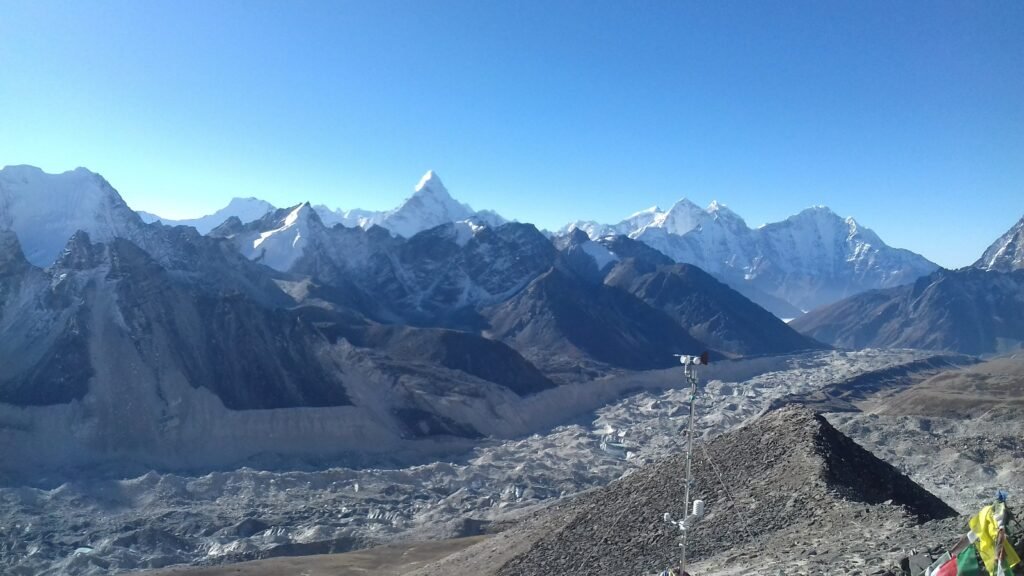
The Journey to Kala Patthar – Step-by-Step
Reaching the summit of Kala Patthar Everest Viewpoint is the crowning achievement of the Everest Base Camp Trek, a journey that combines natural beauty, cultural discovery, and physical endurance. The trail to Kala Patthar takes you through the heart of the Khumbu Valley, where every step leads closer to the top of the world. Though challenging, this adventure rewards you with one of the most awe-inspiring views on Earth — the mighty Mount Everest standing right before your eyes.
Short Overview of the Everest Base Camp Route Leading to Gorakshep
The classic trek to Everest Base Camp Trek begins with a scenic mountain flight from Kathmandu to Lukla (2,840 m), the gateway to the Everest region. From there, the trail winds through picturesque Sherpa villages like Phakding and Namche Bazaar, the vibrant trading hub of the Khumbu. After a rest day for acclimatization in Namche, trekkers continue through Tengboche, famous for its ancient monastery and panoramic mountain views, then on to Dingboche and Lobuche, where the air grows thinner and the peaks rise higher around you.
Along the way, trekkers experience the rich culture and traditions of the region, passing through iconic villages and monasteries on the Everest Region Trek. Each stop offers stunning Himalayan views, authentic Sherpa hospitality, and insights into life in the world’s highest settlements.
Finally, you arrive at Gorakshep (5,164 m) — the last settlement before Everest Base Camp and the base point for the climb to Kala Patthar (5,545 m). The landscape here is stark, dominated by glaciers, wind-sculpted ridges, and ice-capped peaks. Gorakshep sits on a frozen sandy plain once covered by the Khumbu Glacier, now a gathering point for trekkers resting before their ultimate ascent.
The Final Climb to the Kala Patthar Summit
From Gorakshep, the ascent to Kala Patthar is both short and steep. The climb usually takes 2 to 3 hours uphill, depending on your pace and acclimatization. Most trekkers begin their hike early in the morning, around 4:00 to 5:00 a.m., to reach the summit in time for the legendary sunrise over Mount Everest.
The trail begins gently but soon becomes steeper, zigzagging over rocky terrain and loose gravel. Prayer flags flutter in the icy wind as you ascend the ridge, the air growing thinner with each step. Despite the physical challenge, the reward is beyond imagination — with every few meters climbed, Everest looms larger, and the entire Khumbu Glacier comes into view below.
As you approach the top, the last section is a scramble over dark volcanic boulders — the “black rocks” that give Kala Patthar its name. The summit is marked by a cluster of prayer flags that dance wildly in the cold Himalayan breeze. From here, the view is nothing short of divine: Mount Everest, Nuptse, Lhotse, Pumori, and Ama Dablam form a 360° wall of snow and sky. It’s the closest you can stand to Everest without climbing it.
Trek Duration, Elevation Gain, and Challenges
The trek from Gorakshep to Kala Patthar and back typically takes 3 to 4 hours round trip. The climb involves an elevation gain of approximately 400 meters, but at this altitude, the low oxygen level makes it feel much more demanding. The temperature can drop below freezing, especially before sunrise, and strong winds often whip across the exposed ridges.
The primary challenge is altitude. With oxygen levels reduced by almost 50% compared to sea level, trekkers often move slowly, breathing deeply and taking frequent breaks. Physical fitness helps, but the key to success is proper acclimatization, mental determination, and a steady pace.
Despite its difficulty, the climb is considered safe and achievable for most well-prepared trekkers, especially under the guidance of experienced professionals from Mountain King Treks – the Best Trekking Agency in Nepal. Our guides monitor your health and pacing carefully, ensuring you reach the summit safely and comfortably.
Preparation and Acclimatization Tips
To conquer Kala Patthar Everest Viewpoint, preparation begins long before the final climb. Here are essential tips recommended by Mountain King Treks to make your ascent smooth and enjoyable:
- Acclimatize Properly: Spend at least two acclimatization days — one at Namche Bazaar (3,440 m) and another at Dingboche (4,410 m). These stops allow your body to adjust to the high altitude gradually.
- Hydration is Key: Drink plenty of water and avoid alcohol or sleeping pills, which can interfere with acclimatization.
- Trek Slowly and Steadily: Pace yourself, especially on the steep sections. The slower you climb, the higher your chance of reaching the summit safely.
- Dress in Layers: Temperatures drop sharply before dawn. Layer your clothing to stay warm yet flexible.
- Carry Light but Essential Gear: Headlamp, trekking poles, warm gloves, a neck gaiter, and a thermos of warm tea can make the climb more comfortable.
- Mental Preparedness: The thin air and exhaustion can test your determination. Focus on the goal — the breathtaking view that awaits you at the top.
With proper acclimatization, strong preparation, and the support of expert Sherpa guides, the climb to Kala Patthar becomes a thrilling and deeply emotional journey. Each step brings you closer not only to the physical summit but also to a profound inner triumph — standing face-to-face with the world’s highest mountain.
For trekkers seeking a once-in-a-lifetime Himalayan experience, Everest Base Camp Trek and the Everest Region Trek with Mountain King Treks ensures every moment of your Kala Patthar Everest Viewpoint adventure is safe, inspiring, and unforgettable — a journey that defines the very spirit of high-altitude trekking in Nepal.
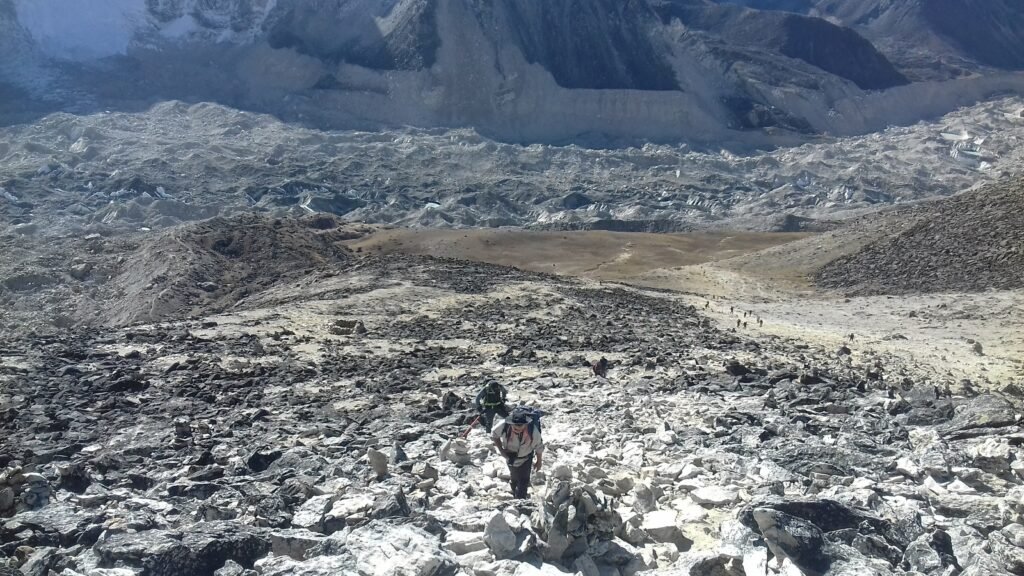
The Experience at the Summit – Face to Face with Mount Everest
Standing atop Kala Patthar (5,545 m) is an experience that transcends physical achievement — it is emotional, spiritual, and awe-inspiring. For trekkers who have journeyed through the rugged trails of the Khumbu Valley, this moment represents the culmination of days of perseverance, endurance, and deep connection with the Himalayas.
Emotional and Spiritual Moment at the Top
Reaching the summit is often described by trekkers as a life-changing moment. The thin Himalayan air, the cold wind, and the effort of the climb suddenly fade away as the vast panorama unfolds. Many climbers report feeling a sense of humility, awe, and inner peace, surrounded by some of the highest peaks on Earth. This is not just a physical triumph — it is a spiritual encounter with nature at its rawest and most majestic form.
Prayer flags fluttering across the rocky ridge mark the sacredness of the spot, representing the Sherpa tradition of connecting with the divine through the mountains. For many, standing here is a moment of reflection, gratitude, and profound connection with the natural and spiritual world.
The Closest Possible View of Everest Without Mountaineering
From the summit of Kala Patthar, trekkers experience the closest and most intimate view of Mount Everest that can be achieved without climbing the mountain itself. Unlike Everest Base Camp, where the peak is partially obscured by Nuptse, Kala Patthar offers an unobstructed, frontal view of Everest’s summit. You can see every ridge, every snow plume, and every glacier line in extraordinary detail — a perspective that few people in the world ever witness.
This proximity allows photographers and adventurers to capture images that seem almost unreal, as if Everest itself is within reach. It is the ultimate reward for anyone who dreams of seeing the world’s highest peak up close, and the thrill of being so near the summit is emotionally overwhelming for many trekkers.
Breathtaking Himalayan Panorama
The summit is also a 360° natural amphitheater of peaks, glaciers, and valleys. From here, you can see Nuptse, Lhotse, Pumori, Ama Dablam, Cholatse, and Taboche forming an endless wall of ice and rock. The Khumbu Glacier sprawls below, winding its way through the valleys, while the distant peaks of the Solu-Khumbu region fade into a hazy blue horizon.
Whether it is sunrise or sunset, the view transforms dramatically, painting the mountains in shades of gold, crimson, and violet. The panorama is not only breathtaking — it is life-affirming, a reminder of the power, beauty, and scale of the Himalayas.
For many trekkers, the summit of Kala Patthar is where mountain dreams become reality, where the effort of days of trekking meets the reward of unforgettable Himalayan vistas. With the guidance of Mountain King Treks – the Best Trekking Agency in Nepal, your summit experience is safe, inspiring, and deeply fulfilling. Every moment at the top becomes a memory that will last a lifetime, leaving an indelible mark on your heart and soul.
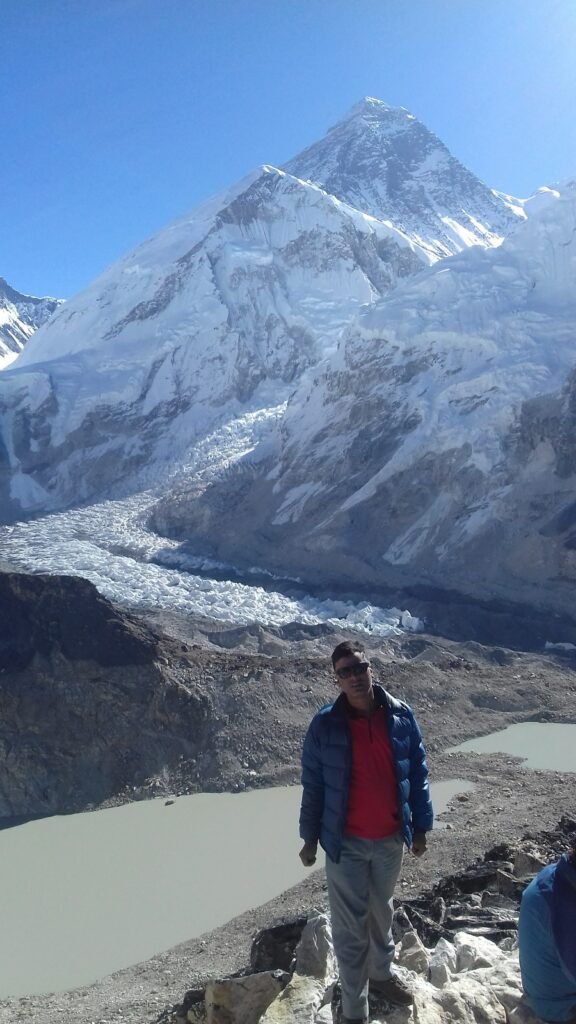
Best Time to Visit Kala Patthar – Seasonal Guide and Weather Tips
Planning the perfect time to witness the Kala Patthar Everest Viewpoint can make all the difference between a good trek and a truly unforgettable Himalayan experience. Since weather in the high Himalayas plays a vital role in visibility and safety, choosing the right trekking season ensures you enjoy the clearest panoramic views of Mount Everest and the best overall trekking conditions.
Ideal Seasons: Spring (March–May) and Autumn (September–November)
The two most popular and best seasons to visit Kala Patthar are Spring (March to May) and Autumn (September to November). These months offer the most stable weather, pleasant temperatures, and crystal-clear visibility, making them perfect for both trekking and photography.
During Spring, the Everest Base Camp Trek route bursts into life with blooming rhododendron forests, colorful alpine flowers, and fresh mountain air. The skies are typically clear in the mornings, and the daytime temperatures are comfortable for trekking. As you ascend toward Gorakshep and Kala Patthar, the weather remains calm, offering the best chance to see Mount Everest, Lhotse, Nuptse, Pumori, and Ama Dablam glowing beneath deep blue skies.
Autumn is equally — if not more — spectacular. After the monsoon rains, the air becomes crystal-clear, the trails are fresh and clean, and the visibility of the Himalayan peaks is unmatched. Autumn mornings and evenings are particularly beautiful, with vivid sunrises and golden sunsets over Everest that photographers dream of capturing. This is also the season when the Khumbu region celebrates cultural festivals like Mani Rimdu, giving trekkers a chance to witness authentic Sherpa traditions along the way.
Weather Conditions and Visibility
At high altitudes like Kala Patthar (5,545 m), temperatures can drop dramatically, even in the best seasons. Early morning climbs often see temperatures as low as -10°C to -15°C (14°F to 5°F), while daytime temperatures remain between 0°C and 10°C depending on sunlight and wind. Despite the cold, the visibility is at its absolute best, allowing trekkers to capture the most stunning panoramic views of Mount Everest and surrounding peaks.
Because Kala Patthar is known for its sunrise and sunset views, timing your ascent is essential. Morning climbs often reward trekkers with glowing golden hues over the mountains, while evening hikes offer dramatic colors and soft light for photography. With clear skies and low wind speeds during Spring and Autumn, these are the ideal times to experience the full beauty of the Everest region.
Off-Season Travel Advice (Winter and Monsoon)
While Spring and Autumn are ideal, off-season trekking can also be an adventurous and rewarding experience for seasoned hikers seeking solitude.
During Winter (December to February), the region experiences cold temperatures, heavy snowfall, and icy trails — but the views can be incredibly clear. The number of trekkers drops significantly, offering a peaceful, crowd-free journey through the Everest Base Camp Trek route. However, reaching Kala Patthar during this period requires proper gear, warm clothing, and expert guidance from professional guides like Mountain King Treks, ensuring your safety in freezing conditions.
Monsoon season (June to August) brings heavy rainfall at lower elevations, cloud cover, and slippery trails. However, higher up near Gorakshep and Kala Patthar, rain is lighter, and misty clouds often create a mystical atmosphere. Trekkers who don’t mind a little unpredictability and want to experience the Himalayas in solitude may still find this season appealing. But be aware that domestic flights to Lukla are often delayed due to weather, so flexibility is key.
Conclusion: Choosing the Perfect Season for Your Dream Viewpoint
For those dreaming of the ultimate Kala Patthar Everest Viewpoint adventure, the Spring and Autumn seasons remain unbeatable. You’ll enjoy stable weather, vivid mountain views, and comfortable trekking conditions, allowing you to fully immerse yourself in the grandeur of the Himalayas.
Whether you wish to capture the sunrise over Mount Everest, feel the spiritual energy of the Khumbu Valley, or explore deeper into the Everest Region Trek, Mountain King Treks – the Best Trekking Agency in Nepal — ensures your journey to Kala Patthar is perfectly timed, expertly guided, and absolutely unforgettable.
Your dream view of the Roof of the World awaits — and there’s no better time than Spring or Autumn to make it come true.
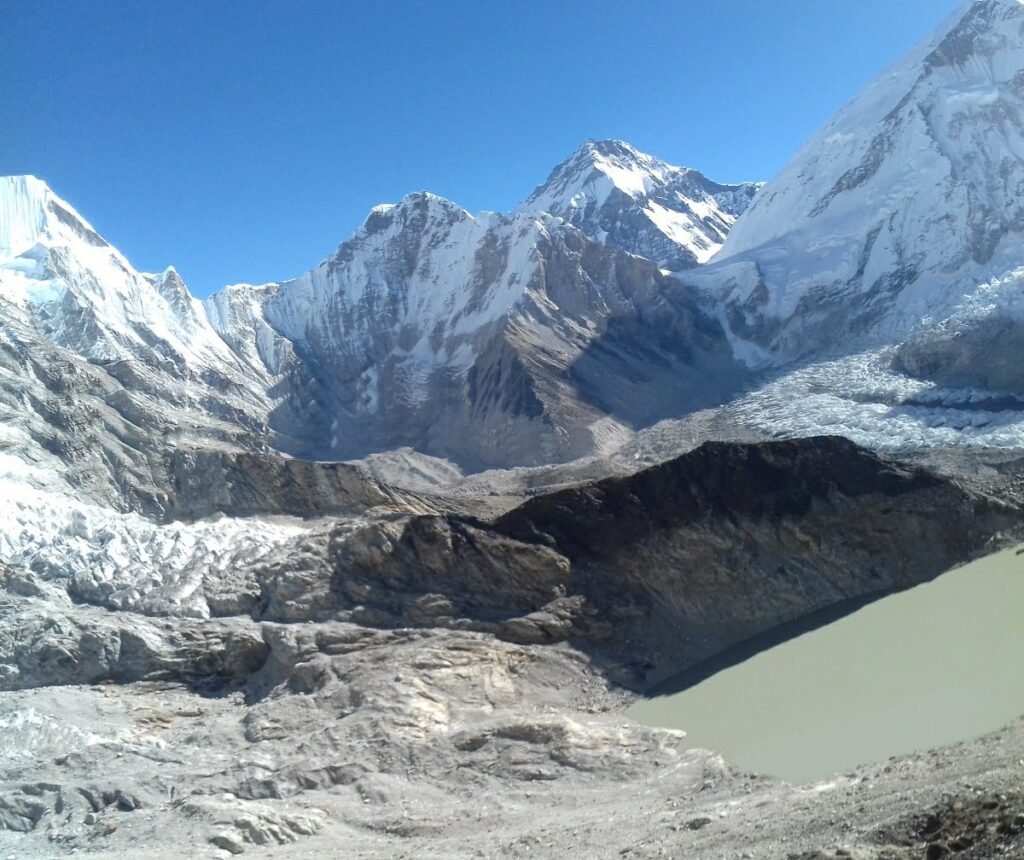
Acclimatization and Safety Tips – Trekking in Nepal’s High Himalayas
Trekking to Kala Patthar and other high-altitude destinations in the Everest Region is an adventure of a lifetime — but it also demands careful preparation, acclimatization, and safety awareness. Reaching elevations above 5,500 meters means your body must adapt gradually to the thin air and changing conditions.
For more in-depth advice on staying fit, hydrated, and prepared at altitude, explore our complete guide on Health & Safety While Trekking in Nepal, designed by Mountain King Treks – the Best Trekking Agency in Nepal. We prioritize your health, comfort, and safety at every step of the journey.
Rest Days and Proper Adaptation
Acclimatization is the key to success in high-altitude trekking in Nepal. During the Everest Base Camp Trek, rest days are strategically placed at Namche Bazaar (3,440 m) and Dingboche (4,410 m) to allow your body to adjust naturally to the reduced oxygen levels. Our experienced guides encourage you to take short hikes to higher elevations during these days — a proven method to boost your endurance and minimize altitude-related risks.
By the time you reach Gorakshep and prepare for the final ascent to Kala Patthar, your body will already be well adapted, allowing you to enjoy the climb safely and confidently.
Recognizing and Preventing AMS (Acute Mountain Sickness)
Altitude sickness, or Acute Mountain Sickness (AMS), can affect anyone regardless of fitness level. Common symptoms include headache, dizziness, fatigue, nausea, and shortness of breath. Our Mountain King Treks leaders are trained in high-altitude first aid and carry essential medical supplies, including portable oxygen and oximeters to monitor your oxygen levels.
We always recommend ascending slowly, staying hydrated, and avoiding alcohol or sleeping pills during the trek. Should any symptoms arise, our guides take immediate action — including descent if necessary — to ensure your safety comes first.
Expert Guidance and Support from Mountain King Treks
With decades of Himalayan experience, Mountain King Treks provides expert guides, porter support, and personalized care throughout the Everest Region Trek. Our team monitors each trekker’s condition daily and shares invaluable local knowledge about the trails, culture, and mountain weather patterns.
You’ll also find comfort in knowing that lodges in the Everest region are well-equipped with cozy rooms, warm dining areas, solar showers, and hot meals — ensuring you stay healthy and energized even in the cold mountain air. For extra preparedness, we recommend carrying a personal medical kit, down jacket, warm sleeping bag (rated to -20°C), and UV-protection sunglasses for high-altitude sunlight.
Gear and Equipment Checklist for the Everest Region
Before beginning your adventure, be sure to review our complete Everest Region Trek Gear Checklist to make sure you’re fully prepared for the Himalayan conditions.
- Warm thermal base layers and windproof outer shells
- Insulated down jacket and trekking trousers
- Sturdy waterproof trekking boots
- Sleeping bag rated for high-altitude cold
- Trekking poles for balance on steep ascents
- Headlamp, water purification tablets, and reusable bottle
- Sunscreen (SPF 50+), lip balm, and UV sunglasses
- First-aid kit with altitude medication
- Energy snacks, dry fruits, and hydration salts
With proper acclimatization, the right gear, and professional guidance from Mountain King Treks, you can trek safely and confidently to Kala Patthar — where the world’s highest peaks will stand right before your eyes, a reward worth every step of your journey through Nepal’s legendary Himalayas.
Perfect — here’s your new expanded H2 section, titled “Essential Trekking Gear and Equipment for Kala Patthar”, with strong SEO focus keywords and your gear checklist link naturally included. It’s crafted to fit seamlessly after your “Acclimatization and Safety Tips” section and optimized for Google ranking with phrases like Everest Region Trek, Kala Patthar Trek, and Trekking in Nepal.
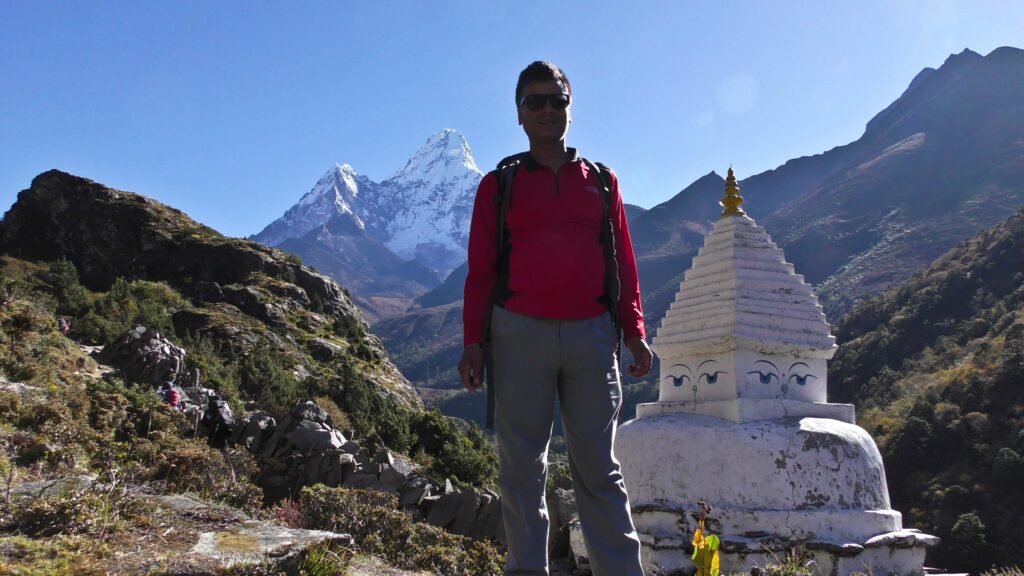
Essential Trekking Gear and Equipment for Kala Patthar
When embarking on the Kala Patthar Trek, preparation is everything. The right trekking gear and equipment not only enhance your comfort but also ensure safety in the extreme Himalayan environment. Since Kala Patthar (5,545 m) lies in one of the highest trekking zones in Nepal, weather conditions can change rapidly — from warm sunshine to sub-zero winds within minutes. Therefore, being well-equipped is the foundation for a successful and enjoyable journey.
Before packing, take time to explore our detailed Everest Region Trek Gear Checklist prepared by Mountain King Treks, the best trekking agency in Nepal, to make sure you have everything essential for your high-altitude adventure.
Clothing and Layering System
Dressing in layers is crucial when trekking to Kala Patthar and the Everest Base Camp. A proper layering system allows you to adjust to the varying temperatures throughout the day and at different altitudes.
- Base Layer: Moisture-wicking thermal tops and bottoms to keep your body dry.
- Insulating Layer: Fleece jacket or down sweater for warmth during chilly mornings and evenings.
- Outer Shell: Waterproof and windproof jacket and pants to protect against snow, rain, and wind.
- Down Jacket: A must-have for nights at Gorakshep or during early-morning climbs to Kala Patthar.
Footwear and Trekking Accessories
Your feet are your foundation during any trek in the Everest Region. Comfortable and durable trekking boots with good ankle support are essential.
- Waterproof trekking boots (well broken-in before the trek)
- Wool or synthetic trekking socks (bring several pairs)
- Gaiters to keep snow and dust out
- Trekking poles to reduce strain on knees during steep ascents and descents
Don’t forget your headlamp for pre-dawn ascents to Kala Patthar and a camera or smartphone with spare batteries — you’ll want to capture the spectacular sunrise view of Mount Everest, Lhotse, and Nuptse from the summit.
Hydration and Health Essentials
Staying hydrated is vital at high altitude. Carry two reusable water bottles or a hydration bladder and use water purification tablets or a filter. Warm beverages like ginger tea or hot lemon are perfect for maintaining hydration and warmth.
Include personal medical supplies such as first-aid kit, blister treatment, altitude medication (Diamox), sunscreen (SPF 50+), and UV-protection sunglasses. A neck gaiter or buff, warm hat, and gloves are must-haves for the freezing winds around Kala Patthar.
Sleeping and Comfort Gear
Although teahouses in the Everest Region Trek provide basic bedding, carrying your own sleeping bag rated to -20°C ensures a comfortable and warm sleep, especially at higher altitudes like Lobuche and Gorakshep. Lightweight travel towels, toiletries, and wet wipes are convenient for personal hygiene in remote areas.
Packing Tip from Mountain King Treks
At Mountain King Treks, we recommend keeping your backpack under 10–12 kg for easy carrying, while your duffel bag with heavier items will be transported by our porters. Before your departure, our experts personally check each trekker’s gear to make sure nothing essential is missing for the challenging Everest Region trekking route.
With the right preparation and the trusted guidance of Mountain King Treks, your journey to Kala Patthar – the best viewpoint of Mount Everest will be not only safe and successful but also an unforgettable Himalayan experience.
Plan Your Kala Patthar Trek with Mountain King Treks
Embark on the Kala Patthar Trek with Mountain King Treks, the Best Trekking Agency in Nepal, and discover the heart of the Himalayas in comfort, safety, and style. Whether you’re looking for group departures filled with adventure companions or private customized treks designed around your pace and interest, we make every journey unforgettable.
Our experienced team takes care of everything — from arranging Everest region trekking permits, domestic flights, and lodges, to providing expert packing checklists and essential acclimatization tips. With Mountain King Treks, you’re guided by seasoned professionals who ensure your journey to Kala Patthar and beyond remains safe, well-organized, and deeply rewarding.
You can also combine this journey with our classic Everest Base Camp Trek for a complete Everest adventure, or explore our full range of Trekking in Nepal experiences to find the route that matches your dream.
For trekkers of all fitness levels, Mountain King Treks offers personal guidance, travel support, and local expertise from start to finish. Let our team handle the logistics while you focus on capturing the awe-inspiring view of Mount Everest from Kala Patthar — an experience that will stay with you forever.

📞 Contact Mountain King Treks – Book Your Kala Patthar Adventure Today
Reach the Best Trekking Agency in Nepal for personalized guidance, expert Himalayan expeditions, and seamless trek planning.
Mountain King Treks And Expedition Pvt. Ltd., Maitrinagar, Kirtipur -2, Kathmandu, Nepal
🌐 Website: www.mountainkingtrek.com
✉️ Email: mountainkingtreks@gmail.com
📱 WhatsApp / Viber: +977-9841566449
Ready to Plan Your Trek?
Click Book Now or contact us directly to customize your Kala Patthar Trek, Everest Base Camp Trek, or any Everest Region adventure with expert support from Mountain King Treks.
Recent Posts
Poon Hill Trek – Short and Scenic Sunrise Trek in the Annapurna Region with Mountain King Treks
How to Stay Safe and Healthy While Trekking in Nepal
The Four Narayan Temples in Four Directions Protecting Kathmandu Valley

Thailand
